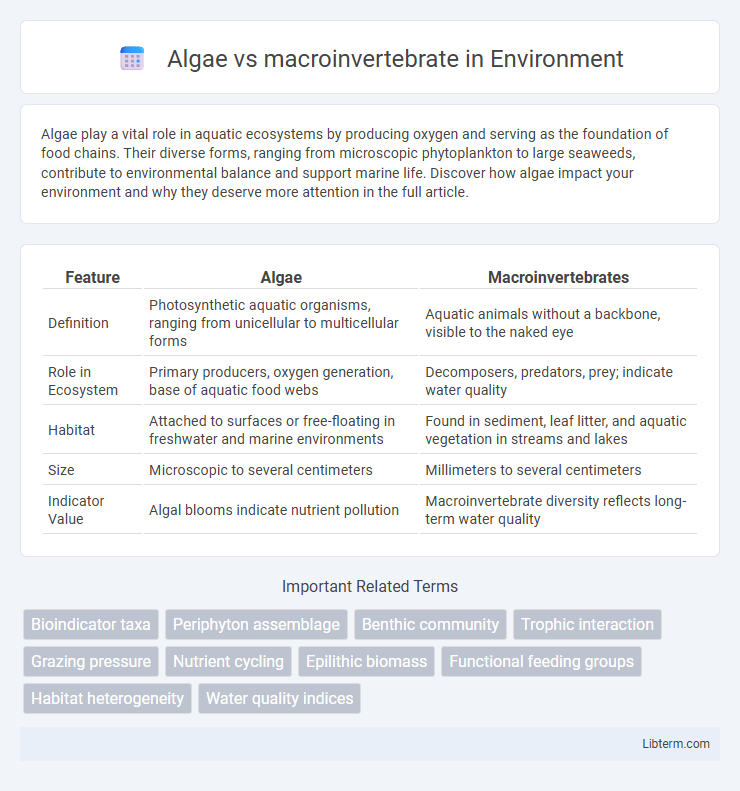Algae play a vital role in aquatic ecosystems by producing oxygen and serving as the foundation of food chains. Their diverse forms, ranging from microscopic phytoplankton to large seaweeds, contribute to environmental balance and support marine life. Discover how algae impact your environment and why they deserve more attention in the full article.
Table of Comparison
| Feature | Algae | Macroinvertebrates |
|---|---|---|
| Definition | Photosynthetic aquatic organisms, ranging from unicellular to multicellular forms | Aquatic animals without a backbone, visible to the naked eye |
| Role in Ecosystem | Primary producers, oxygen generation, base of aquatic food webs | Decomposers, predators, prey; indicate water quality |
| Habitat | Attached to surfaces or free-floating in freshwater and marine environments | Found in sediment, leaf litter, and aquatic vegetation in streams and lakes |
| Size | Microscopic to several centimeters | Millimeters to several centimeters |
| Indicator Value | Algal blooms indicate nutrient pollution | Macroinvertebrate diversity reflects long-term water quality |
Introduction to Algae and Macroinvertebrates
Algae are diverse photosynthetic organisms found in aquatic environments, ranging from microscopic phytoplankton to large seaweeds, and they play a crucial role in oxygen production and as primary producers in the food web. Macroinvertebrates, such as insects, mollusks, and crustaceans, inhabit freshwater systems and serve as key bioindicators for water quality assessment due to their sensitivity to environmental changes. Both algae and macroinvertebrates contribute significantly to ecosystem functioning, supporting nutrient cycling and providing habitat and food for higher trophic levels.
Defining Algae: Types and Characteristics
Algae are diverse photosynthetic organisms classified primarily into microalgae and macroalgae, with microalgae including single-celled species like diatoms and green algae, while macroalgae encompass larger, multicellular forms such as seaweeds. These organisms thrive in aquatic environments, contributing significantly to oxygen production and forming the base of many aquatic food webs. Key characteristics include their ability to photosynthesize through chlorophyll pigments, simple structure without true roots or stems, and varied reproductive strategies ranging from asexual cell division to complex life cycles.
Understanding Macroinvertebrates: Groups and Features
Macroinvertebrates, including insects, mollusks, crustaceans, and worms, serve as critical bioindicators in freshwater ecosystems due to their varied tolerance to pollution and habitat changes. These organisms lack a backbone, making them distinct from algal species that are primarily photosynthetic and form the base of aquatic food webs. Studying macroinvertebrate groups reveals essential features such as gill types, feeding mechanisms, and life cycle stages, which help assess water quality and ecosystem health more precisely than algae alone.
Habitat Preferences: Where Algae and Macroinvertebrates Thrive
Algae primarily thrive in aquatic environments with ample sunlight, such as clear, nutrient-rich streams and shallow lakes where photosynthesis is efficient. Macroinvertebrates prefer diverse habitats within freshwater systems, including submerged vegetation, gravel beds, and leaf litter zones, offering shelter and varied food sources. Both groups serve as indicators of water quality, with algae favoring well-lit, oxygenated waters and macroinvertebrates occupying niches that reflect sediment type and flow conditions.
Ecological Roles in Aquatic Ecosystems
Algae serve as primary producers, converting sunlight into energy through photosynthesis, which forms the foundation of aquatic food webs and supports diverse aquatic organisms. Macroinvertebrates act as key consumers and decomposers by feeding on algae, detritus, and organic matter, thereby recycling nutrients and maintaining ecosystem health. Together, algae and macroinvertebrates regulate water quality, oxygen levels, and energy flow in freshwater and marine ecosystems.
Algae vs Macroinvertebrate: Food Web Dynamics
Algae serve as primary producers in aquatic ecosystems, converting sunlight into organic matter that fuels the food web, while macroinvertebrates function as primary consumers and decomposers, feeding on algae and detritus. The dynamic interaction between algae and macroinvertebrates regulates nutrient cycling and energy flow, supporting fish and higher trophic levels. Changes in algal biomass directly affect macroinvertebrate diversity and abundance, influencing overall ecosystem stability and productivity.
Indicators of Water Quality: Bioassessment Comparisons
Algae serve as primary producers in aquatic ecosystems, with species composition and abundance directly reflecting nutrient levels and light availability, making them sensitive indicators of eutrophication and pollution. Macroinvertebrates, as consumers with varying tolerances to pollutants, provide integrative bioassessment through community diversity, abundance, and functional feeding groups, revealing cumulative impacts of water quality over time. Comparing both indicators enhances water quality assessments by combining algae's rapid response to chemical changes with macroinvertebrates' ability to indicate long-term ecosystem health and habitat conditions.
Response to Environmental Stressors
Algae exhibit rapid physiological changes in response to environmental stressors such as nutrient fluctuations, light availability, and water temperature, serving as early indicators of ecosystem health. Macroinvertebrates respond more slowly but reflect longer-term environmental conditions through changes in species diversity and abundance, making them valuable for assessing cumulative pollution impacts. The combined analysis of algae and macroinvertebrate responses offers comprehensive insights into the temporal dynamics of aquatic ecosystem stress.
Human Impacts on Algae and Macroinvertebrate Populations
Human activities such as nutrient pollution from agriculture and urban runoff significantly alter algae and macroinvertebrate populations by causing eutrophication and habitat degradation. Elevated nutrient levels promote harmful algal blooms, disrupting aquatic ecosystems and reducing oxygen levels critical for macroinvertebrates. Industrial discharges and sedimentation further degrade benthic habitats, leading to decreased macroinvertebrate diversity and abundance, which negatively impacts water quality and ecosystem health.
Future Perspectives and Conservation Strategies
Emerging research emphasizes integrating algae and macroinvertebrate monitoring to enhance aquatic ecosystem health assessments, leveraging advancements in molecular techniques like environmental DNA (eDNA) for precise biodiversity tracking. Conservation strategies increasingly prioritize habitat restoration, pollution control, and climate change mitigation to support both algae populations critical for primary productivity and diverse macroinvertebrate communities essential for trophic dynamics. Future perspectives highlight the development of holistic management frameworks that incorporate multi-trophic level indicators to improve resilience and sustainability of freshwater ecosystems.
Algae Infographic

 libterm.com
libterm.com